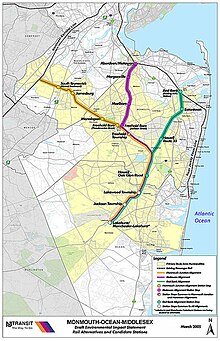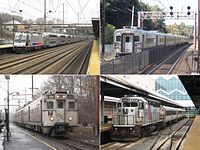
Freehold is a borough and the county seat of Monmouth County, in the U.S. state of New Jersey. Known for its Victorian era homes and extensive colonial history, the borough is located in the Raritan Valley region within the New York Metropolitan Area, located about 33 miles (53 km) from Manhattan and 17 miles (27 km) from Staten Island. The borough has grown to become a commuter town of New York City. As of the 2020 United States census, the borough's population was 12,538, its highest decennial count ever and an increase of 486 (+4.0%) from the 12,052 recorded at the 2010 census, which in turn had reflected an increase of 1,076 (+9.8%) from the 10,976 counted at the 2000 census.

New Jersey Transit Corporation, branded as NJ Transit or NJTransit and often shortened to NJT, is a state-owned public transportation system that serves the U.S. state of New Jersey and portions of the state of New York and Pennsylvania. It operates bus, light rail, and commuter rail services throughout the state, connecting to major commercial and employment centers both within the state and in its two adjacent major cities, New York City and Philadelphia. In 2022, the system had a ridership of 175,960,600.

NJ Transit Rail Operations is the rail division of NJ Transit. It operates commuter rail service in New Jersey, with most service centered on transportation to and from New York City, Hoboken, and Newark. NJ Transit also operates rail service in Orange and Rockland counties in New York under contract to Metro-North Railroad. The commuter rail lines saw 45,838,200 riders in 2022, making it the third-busiest commuter railroad in North America and the longest commuter rail system in North America by route length.
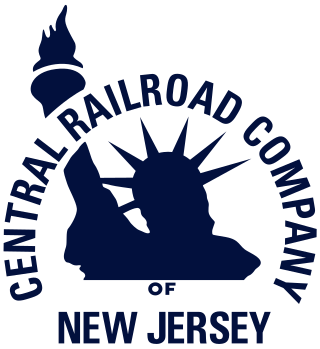
The Central Railroad of New Jersey, also known as the Jersey Central, Jersey Central Lines or New Jersey Central, was a Class I railroad with origins in the 1830s. It was absorbed into Conrail in April 1976 along with several other prominent bankrupt railroads of the Northeastern United States.
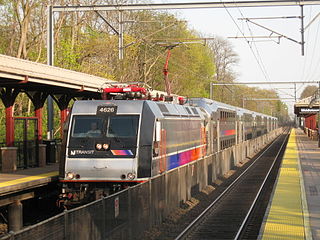
The North Jersey Coast Line is a commuter rail line running from Rahway to Bay Head, New Jersey, traversing through the Jersey Shore region. Operated by New Jersey Transit, the line is electrified as far south as Long Branch. On rail system maps it is colored light blue, and its symbol is a sailboat. The line runs along the former New York & Long Branch Railroad, which was co-owned by the Central Railroad of New Jersey and the Pennsylvania Railroad.

The Raritan Valley Line is a commuter rail service operated by New Jersey Transit (NJT) which serves passengers in municipalities in Union, Somerset, Middlesex and Hunterdon counties in the Raritan Valley region in central New Jersey, United States. The line's most frequent western terminus is Raritan station in Raritan. Some weekday trains continue farther west and terminate at the High Bridge station, located in High Bridge. Most eastbound trains terminate in Newark; passengers bound for New York make a cross-platform transfer. A limited number of weekday trains continue directly to New York.

The Atlantic City Line (ACL) is a commuter rail line operated by NJ Transit (NJT) in the United States between Philadelphia, Pennsylvania and Atlantic City, New Jersey, operating along the corridor of the White Horse Pike. It runs over trackage that was controlled by both the Pennsylvania Railroad (PRR) and the Pennsylvania-Reading Seashore Lines. It shares trackage with SEPTA and Amtrak on the Northeast Corridor (NEC) until it crosses the Delaware River on its own Delair Bridge into New Jersey.

The Henry Hudson Trail is a rail trail in western and northern Monmouth County, New Jersey. The trail is named for Henry Hudson, who explored the harbor at Atlantic Highlands and the Raritan Bayshore coastline in the early 1600s. The 24-mile-long (39 km), 10-foot-wide (3.0 m) paved multi-use trail is part of the Monmouth County Park System. The rail trail traverses the Raritan Bayshore region from Highlands and connects inland to Freehold Borough using the former rights-of-way of several rail lines. Although trees line much of the trail, it affords some views of surrounding wetlands, streams, woodlands and fields. It traverses through the municipalities of Freehold Township, Marlboro Township, Matawan, Aberdeen Township, Keyport, Union Beach, Hazlet, Keansburg, Middletown Township, and Atlantic Highlands.
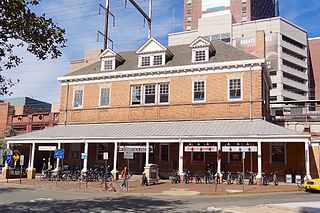
New Brunswick is an active commuter railroad train station in the city of New Brunswick, Middlesex County, New Jersey. The station services trains of New Jersey Transit's Northeast Corridor Line and Amtrak's Keystone Service and Northeast Regional. For New Jersey Transit trains, the next station to the southwest is Jersey Avenue, while the next station to the northeast is Edison. For Amtrak services, the next station southwest is Princeton Junction, the next station to the northeast is Metropark. The station consists of two handicap-accessible side platforms surrounding the four tracks.

Cranford is an active commuter railroad station in the township of Cranford, Union County, New Jersey. Trains operate between High Bridge and Newark Penn Station on New Jersey Transit's Raritan Valley Line. The next station east is Roselle Park while west is Garwood. Cranford station contains two side platforms to service three tracks and is accessible for handicapped persons under the Americans with Disabilities Act of 1990.
The Freehold and Jamesburg Agricultural Railroad was a short-line railroad in New Jersey. The railroad traversed through the communities of Freehold Borough, Freehold Township, Manalapan Township, Englishtown Borough, Monroe Township, and Jamesburg Borough, en route to Monmouth Junction in South Brunswick Township. Its former right-of-way, along with a portion of the Farmingdale and Squan Village Railroad's right-of-way, has become the Edgar Felix Bikeway and the Freehold right-of-way between Route 537 and Big Brook Park in Marlboro Township has become the Henry Hudson Trail. The section of right of way from Route 537 parallel to Jackson Street and behind the former Karagheusian Rug Mill to the former Central Railroad of New Jersey depot on Jackson Street at Mechanic Street in Freehold Borough has not as of yet been improved to be part of the trail. It is not clear whether this part of the right of way is still owned by New Jersey Transit which owns the rest of the line north into Matawan. The latter has been ‘railbanked’ which means it can be reactivated
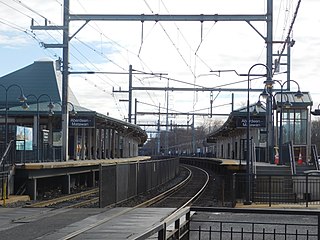
Aberdeen–Matawan is a station on NJ Transit's North Jersey Coast Line, located in Aberdeen and Matawan, Monmouth County, New Jersey, United States. This station, convenient to Route 35 and the PNC Bank Arts Center, is popular with both commuters and concertgoers, and is the busiest station on the line between Bay Head and Rahway.

The New Jersey Southern Railroad was a railroad that started in 1854. It would continue under this name until the 1870s as a separate company and the lines that it had constructed or run continued to be run in the New Jersey Southern name until the early 2000s.

Bus rapid transit in New Jersey comprises limited-stop bus service, exclusive bus lanes (XBL) and bus bypass shoulders (BBS). Under the banner Next Generation Bus New Jersey Transit (NJT), the New Jersey Department of Transportation (NJDOT), and the metropolitan planning organizations of New Jersey (MPO) which recommend and authorize transportation projects are undertaking the creation of several additional bus rapid transit systems (BRT) in the state.
Lakewood Terminal is a regional bus terminal owned and operated by NJ Transit (NJT) at 1st & Lexington Avenues in Lakewood, New Jersey. Bus service includes routes to Atlantic City, Hudson County, New York, Philadelphia, and points at the Jersey Shore, including those of the Ocean County bus network, Ocean Ride. It is situated near the intersection of Route 88 and U.S. Route 9, a busy commuter corridor and the former Central Railroad of New Jersey right-of-way, where the MOM rail line may eventually travel. There are 92 parking spaces available at the bus station.
The Southern Secondary is a rail line in New Jersey, operated by Conrail Shared Assets Operations (CSAO) from South Amboy to Red Bank, and the Delaware and Raritan River Railroad (DRR), a subsidiary of Chesapeake and Delaware, LLC, between Red Bank and Lakewood. The entire active portion of the line is owned by NJ Transit. The active portion of the line runs from South Amboy to the current end of track at Lakewood. The line is owned by NJ Transit, but the southern portion, is not shared with passenger trains. Beyond Lakewood, the tracks are owned by CSAO as far as Lakehurst, but are inactive between Lakewood and Lakehurst.
The Operating Passenger Railroad Stations Thematic Resource is a list of 53 New Jersey Transit stations in New Jersey entered into the New Jersey Register of Historic Places and National Register of Historic Places in 1984 for their architectural, historical, and cultural merit.
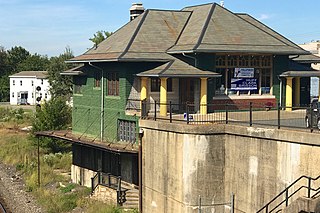
Phillipsburg Union Station is an inactive railroad station in Phillipsburg, New Jersey, United States, at 178 South Main Street. Opened in 1914, Union Station was built by the Delaware, Lackawanna & Western Railroad (DL&W) and shared with the Central Railroad of New Jersey (CNJ) and was situated where the lines merged before the bridge crossing the Delaware River. Designed by Frank J. Nies, the architect who produced many of DL&W stations now listed state and federal registers of historic places, the 2+1⁄2 story, 3 bay brick building is unusual example of a union station and a representation of early 20th century Prairie style architecture. The Phillipsburg Union Signal Tower, or PU Tower, is nearby.

Elizabeth is a disused train station in Elizabeth, New Jersey. It was built by the Central Railroad of New Jersey (CNJ) in 1893. It is adjacent to NJ Transit's Elizabeth station on the Northeast Corridor. That station was built and owned by the Pennsylvania Railroad; in the era of private operation passengers could transfer between the two. The CNJ right-of-way in Elizabeth is unused, and passenger trains which served the former CNJ mainline bypass Elizabeth via the Aldene Connection on their way to Newark Penn Station. The station has been renovated and used as commercial space.


